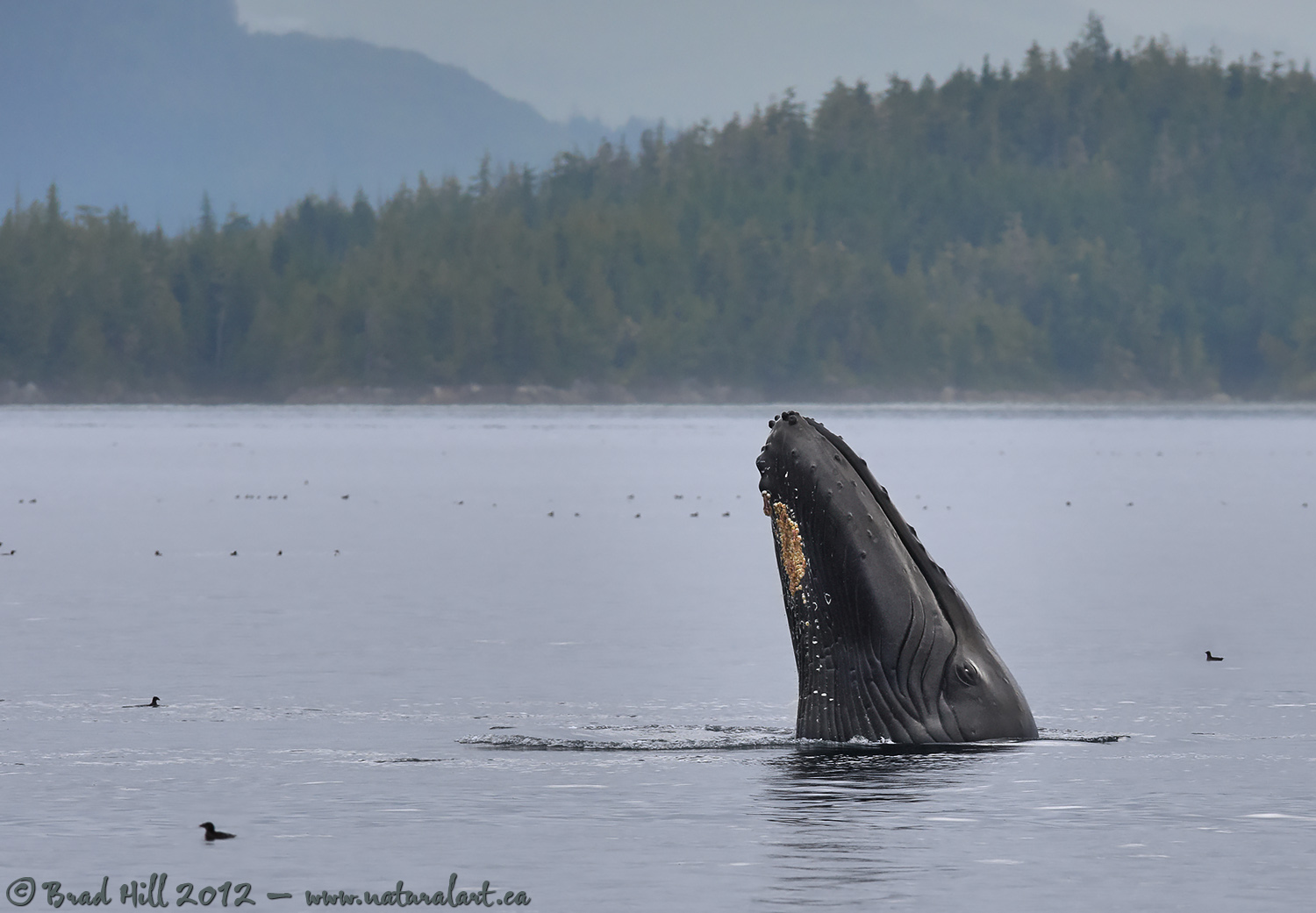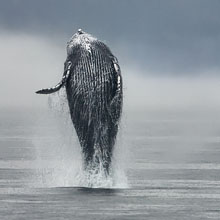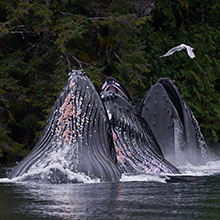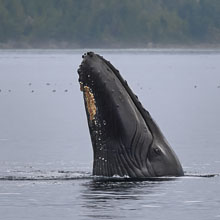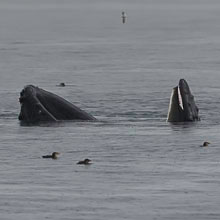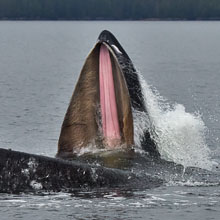Availability: Undetermined - Enquiries?
In the Field
Getting the Eye! Johnstone Strait Region, Vancouver Island, BC, Canada. August 23, 2012.
It's almost a magical experience to lock eyes with several species of animals - it feels almost as though some form of ancestral bond is being revived or renewed. I've experienced it many times with wolves and bears and each time is as exhilarating as the first. But when this fully grown Humpback Whale emerged from the water and froze in place and gave me (or us?) the eye...well..it was simply an unforgettable moment! I won't say "...you haven't lived until you've looked into the eye of a whale..." - but I'm tempted to! ;-)
This behaviour - when a whale raises its head above water and remains motionless for a few seconds in a manner akin to treading water - is known as spyhopping. Spyhopping is not an uncommon behaviour with some species of whales or dolphins (such as Killer Whales) and has even been known to occur in Great White Sharks and Blacktip Reef Sharks. But this was the first time I had ever observed the behaviour in humpbacks. Its function? Pretty much as you'd guess - to have a look around. Why a humpback would care about what's going on above the water (especially given that everything it feeds on is under the water's surface) is anybody's guess, but I have to say I feel privileged that this whale deemed us worth a look!
For those who might be wondering - the "crusty-looking" orange mass on the underside of the whale's lower jaw are barnacles. And most of the birds visible on the surface of the water are Rhinoceros Auklets.
ADDITIONAL NOTES:
NOTE 1: This image - in all resolutions - is protected by copyright. I'm fine with personal uses of it (including use as desktop backgrounds or screensavers on your own computer), but unauthorized commercial use of the image is prohibited by law. Thanks in advance for respecting my copyright!
NOTE 2: This image was captured during my "Humpbacks, Orcas, Sea Lions & More!" photo tour in the summer of 2012. Each year I offer trips into two different parts of the Great Bear Rainforest as well as one to photograph aquatic mammals and oceanscapes near the northern tip of Vancouver Island. And, in selected years, I also offer photo tours to locations to capture other highly sought-after subjects, such as various owl species of the boreal forest and wildlife of Canada's Arctic. Details about these trips can be found on the Photo Tours page of this website.
NOTE 3: Like all wildlife photographs on this website, this image was captured following the strict ethical guidelines described in The Wildlife FIRST! Principles of Photographer Conduct. I encourage all wildlife photographers to always put the welfare of their subjects above the value of their photographs.
Behind the Camera
Getting the Eye! Johnstone Strait Region, Vancouver Island, BC, Canada. August 23, 2012.
Digital Capture; RAW 14-bit format; ISO 900.
Nikon D4 paired with Nikkor 400mm f2.8 VRII lens. Hand-held from deck of sailboat. VR on and set to "normal" mode.
1/2000s @ f6.3; no compensation from matrix-metered exposure setting.
At the Computer
Getting the Eye! Johnstone Strait Region, Vancouver Island, BC, Canada. August 23, 2012.
RAW Conversion to 16-bit TIFF, including first-pass/capture sharpening using Capture One Pro. Two raw variants (processed from raw) differing by a total of 1.0 stops in exposure.
Further digital corrections on resulting 16-bit TIFF files using Adobe's Photoshop CS6 and Light Craft's Lightzone. Photoshop adjustments including compositing the raw conversion variants (layering and masking), selective contrast (curves) adjustment, selective tweaks to exposure (all using adjustment layers), and selective sharpening for web output. Final tone tweaking performed using tonemapper/re-light tool in Lightzone.
Conservation
Getting the Eye! Johnstone Strait Region, Vancouver Island, BC, Canada. August 23, 2012.
Ten percent of the revenue generated by this image will be donated to Raincoast*.
Species Status in Canada**: Threatened - North Pacific population (May 2003).
Humpback Whales (Megaptera novaeagnliae) are active, acrobatic whales that can throw themselves completely clear of the water (a behaviour known as breaching) and will swim on their backs with both flippers in the air. Humpbacks are large (up to 14m - or 46 feet - in length and 40 tonnes in weight) and with huge flippers.
Humpbacks are found in tropical, temperate, and sub-polar waters around the world. They are found on both the east and west coasts of North America. The North Pacific population has been estimated at between 6,000 and 8,000 individuals, but only a few hundred of these are found in the waters off the coast of British Columbia.
While Humpbacks are recovering from the damage done to their populations by commercial fishing, the are still subject to a variety of threats from human activities, including becoming entangled in fishing nets, noise and chemical pollution and habitat destruction.
*The Raincoast Conservation Society (and Foundation) is an effective and efficient organization that has been fighting for protection of this unique habitat. If you are looking for a meaningful way to contribute to the conservation of this amazing ecosystem, Raincoast will provide maximal "bang" for your conservation dollars.
**as determined by COSEWIC: The Committee on the Status of Endangered Wildlife in Canada












